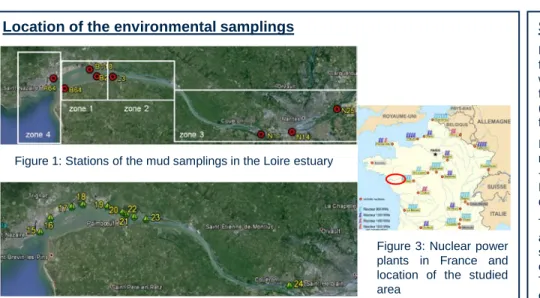HAL Id: in2p3-01045028
http://hal.in2p3.fr/in2p3-01045028
Submitted on 24 Jul 2014
HAL is a multi-disciplinary open access
archive for the deposit and dissemination of
sci-entific research documents, whether they are
pub-lished or not. The documents may come from
teaching and research institutions in France or
abroad, or from public or private research centers.
L’archive ouverte pluridisciplinaire HAL, est
destinée au dépôt et à la diffusion de documents
scientifiques de niveau recherche, publiés ou non,
émanant des établissements d’enseignement et de
recherche français ou étrangers, des laboratoires
publics ou privés.
Determination and speciation of anthropogenic tritium
in the Loire River estuary (France).
O. Péron, Pastor L., C. Gégout, Elise Fourré, F. Siclet, Gilles Montavon,
Catherine Landesman
To cite this version:
O. Péron, Pastor L., C. Gégout, Elise Fourré, F. Siclet, et al.. Determination and speciation of
anthropogenic tritium in the Loire River estuary (France).. Goldschmidt 2014, 2014, Sacramento,
United States. �in2p3-01045028�
To estimate the non-exchangeable OBT activity in these samples (eq. 1), the exchangeable fraction of hydrogen (α coefficient) within the matrices has to be known (eq. 2). A dedicated experimental set up was thus developed. It consists in a temperature and humidity controlled glove box where different environmental matrices are exposed to specific atmospheres with fixed T/H vapour pressure ratios. The calibration phase of
the method is being performed using a α-cellulose matrix with D/H (deuterium) vapourpressure ratios set by
water from the station Concordia at Dome C in Antarctica.
The aim of radioecology is to understand the transfer of radionuclides through the ecosystem. It relies strongly on field studies which can provide useful informations on the presence of radionuclides in the environment, and their origins (natural and anthropogenic). In this study, the radioactive isotope of hydrogen, i.e. tritium (3H or T), is considered. Tritium is a beta emitter with a radioactive half life of 12.3 years.
Environmental tritium occurs in three main forms: tritiated water (HTO or tissue free water), organically bound tritium (OBT) and tritiated gas (HT). Tritiated water is the most abundant chemical form of tritium in the aquatic and terrestrial environment. OBT can be subdivided in two fractions: the exchangeable OBT refers to tritium atoms that are easily exchanged (e.g. bound to nitrogen, oxygen or sulfur atoms), while the non-exchangeable OBT refers to the OBT covalently bound to carbon atoms. Because of its longer residence time in plants and living organisms, the radiological significance of non-exchangeable OBT is greater than that of HTO. In this study, mud and water samples from the Loire estuary, downstream from several nuclear power plants, were analyzed.
Determination and speciation of anthropogenic
tritium in the Loire River estuary (France)
O. PÉRON1*, L. PASTOR2, C. GÉGOUT1, E. FOURRÉ3, F. SICLET2, G. MONTAVON1, C. LANDESMAN1
1SUBATECH, UMR 6457, 4 rue Alfred Kastler, 44307 Nantes, France (*corresponding: olivier.peron@subatech.in2p3.fr)
2EDF, LNHE, 6 quai Wattier 78400 Chatou Cedex, France
3LSCE, Orme des Merisers, CEN Saclay, 91191 Gif sur Yvette Cedex, France
Acknowledgements: Authors would like to thank NEEDS-Environnement and RS2E-OSUNA projects for fundings. The authors thank also Ifremer and LPGN-BIAF for the technical support. Figure 4: tritium volume activity in HTO
and OBT forms in mud samples
Figure 5: tritium volume activity and salinity of surface water samples
Location of the environmental samplings
Context & objectives
Observations & results
Figure 1: Stations of the mud samplings in the Loire estuary
Figure 2: Transect of the surface water samplings in the Loire estuary
Samplings, treatments & analyses
Mud samples were recovered from the river floor with a Van Veen grab (Figure 1) and water samples were continuously pumped from the river surface during the transect (Figure 2). The environmental samples were freezed (-28°C) for an efficient storage. In order to recover, free HTO and total OBT,mud samples were freeze-dryed (10-3 mbar,
- 57°C) and burnt (combustion) respectively. In order to recover HTO, water samples were distilled.
The specific 3H activities of the combustion
and free waters were measured by liquid scintillation counting using Ultima Gold LLT cocktails (PerkinElmer Tri-carb 3170 TR/SL). The results were corrected for quenching effects. The overall uncertainty value is ± 15% (2σ).
Figure 3: Nuclear power plants in France and location of the studied area
HTO and total OBT activities from mud samples range from 4 to 26 Bq.L-1 and from 10 to 25
Bq.L-1, respectively (Figure 4).
The European follow-up
indicator is 100 Bq.L-1. The
average 3H volume activities in
precipitation over the continental
surface in the Northern
hemisphere was estimated to be < 3 Bq.L-1 in 2012.
HTO activities of distilled
surface water samples decrease with increasing salinity from 21 to 7 Bq.L-1 (Figure 5). These
results are consistent with the values previously obtained by F. Siclet et al. (2001).
